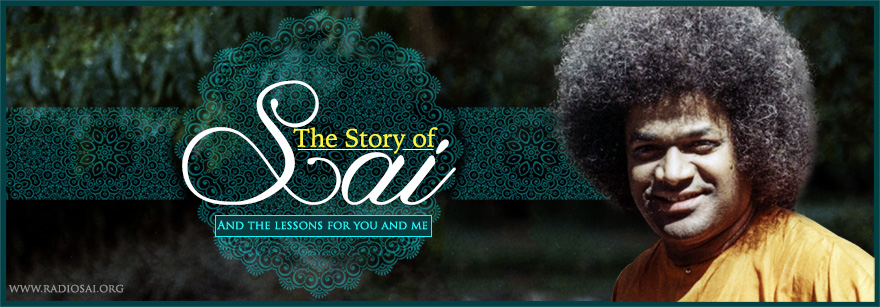|
|
| 'Like' us on Facebook | Follow us: |
Posted on: Nov 25, 2016
The Story of Sai - 3
And the lessons for you and me
Part 1 || Part 2 || Part 4 || Part 05 || Part 06 || Part 07 || Part 08
 |
The antiquity of The Ramayana, The Mahabharata, and The Bhagavatha is unquestionable and indecipherable. Yet in India they are as fresh and alive in people's consciousness as the stories of their own families. Rama, Krishna, Radha, etc. are almost a part of their daily life and living. What makes these legendary tales contemporary in every age? Rama's paintings and sculptures or Krishna's images and carvings, poems on Rama's glory or discussions on Krishna's message, are as passionately done now as they happened in 3 AD or 13 AD or 1300 AD. What makes them defy time and be relevant to every society over ages? Is it the incredible heroics of Rama? Or the delightful and miraculous sport of Krishna? Or the awesome plot of these captivating poetic narrations? While all this is true, what makes these epics eternal is something more fundamental.
 |
|
| 91st Birthday Celebrations Logo - Download |
“The Ramayana and the Mahabharata are like the heart and the head of India, and are as vital to India as the heart and the head are to a human body,” Bhagawan says and goes on to state what makes these epics so vital: “Sathya and dharma are not related to merely one person, one period of time, or one country; they are related to all people, all periods of time, and all countries...” It is because these tales are nothing but beautiful elaborations of Truth and Righteousness, that they have stood the test of time and circumstance. But this essence can be grasped only if these epics are read not as scintillating stories but as reinvigorating treatises on how to lead a life anchored to Truth and Righteousness.
As much as this is true for these ancient epics, it is the same with the current Sai Bhagavatha too. Every scene and character, sequence and incident, twist and turn in the Sai Saga is for the purpose of divinising man through the practice of Truth, Righteousness, Peace and Love. But to assimilate this deeply and internalise it intensely so that it can be translated into real action, the Story of Sai needs to be not just read but meditated upon assiduously. This series, started in November 2016, commemorating Bhagawan's 91st Birthday is an attempt in this direction. We hope this will help us to reflect more profoundly on the Sai Bhagavatha and implement the lessons learnt more powerfully in our day-to-day existence.
His Story
The story of the birth of Puttaparthi is no less mystifying and profound as the advent of Sathya Sai. Many years ago Puttaparthi was called Gollapalli. Gollas refer to the cowherds. So literally it referred to 'a place of cowherds'. It was a milieu similar to Gokul Brindavan of Krishna's times. These cows yielded milk in plenty and the villagers lived in bounty.
However one fateful incident changed everything. A cowherd noticed that one evening his cow returned from the pastures with little milk left in her udders. He was angry, and confused. Where is her milk gone? Why so little? Did anyone steal? He wanted to investigate.
So next day he quietly followed his cow. He noticed that after grazing for a while, she surreptitiously moved away from the herd and set off towards the outskirts of the village. The path was undulating, filled with rocks, stones and hillocks. But his cow marched on. She was in fact in a hurry. She doggedly overcame everything that came in her way and moved on until she reached a particular spot where there was an ant hill. There she stopped. And waited.
In a few seconds, from inside the mound of mud emerged a snake. The dangerous cobra however was a picture of peace. It slowly slithered out of its hole, settled down right below the cow's belly, then raising its hood carefully latched on to the cow's udder and began to merrily drink her milk! The cow too was suckling the gentle serpent with contentment.
“I got you!” The cowherd was enraged. “So this is the drama going on! How dare you drink away my cow's milk!” He seethed with anger at the snake's 'impertinence'. The next moment, without sparing a second thought, he picked up a stone, and hurled it at the cobra with such power and precision that it hit the serpent like a ton of bricks. A splash of blood! The spineless creature collapsed. The snake died, but before it breathed its last it let out a curse: “For taking away my life so stone-heartedly, this place will soon be filled with stones and rocks, snakes and ant hills. Everyone here too will undergo the pain that I was made to go through.”
 |
Reflection
Instead of hailing the selflessness of the cow, and the beautiful harmony in Nature where one being was going out of her way to help another, what man did was destroy a tableau of love, that too in the most dastardly manner. Why? Because of his mindlessness.
When one's mind is overcome with anger and greed, compassion and love disappear. The cowherd did not even spare a moment to analyze and understand why her cow was undergoing all this trouble to provide for a strange serpent. Even if she was doing it for some unexplainable reason, she was not hurting anyone. The only loss the man was experiencing is a reduction in his milk. If a little milk is offered to someone else, that too to a being which cannot speak and maybe is in dire need, should she be punished for it? Is it an unallowable act? Man minus compassion, Baba says, is not only not human but worse than even a beast. The cowherd unfortunately did not demonstrate even an iota of selflessness and sacrifice that the cow exemplified to the whole world. As a result the entire village was covered with a dark future. In fact the snake's curse is symbolic of what happens to us when we heartlessly destroy Nature's genial harmony. Where love diminishes darkness takes over. That's exactly what happened to Gollapalli.
His Story
Soon ant hills popped up all over the place. The ground became red and rocky. Rains were scarce. Pastures turned into playgrounds of snakes. Cattle dwindled. It came to a point where the existence of cowherds became miserable. The only population that rapidly multiplied was the colony of ants.
With cows disappearing, the name 'Gollapalli' became a misnomer. As ants ruled the area, it came to be called 'Puttavardhini' meaning, 'where ant hills thrive'. But the decline of Gollapalli, or to put it differently, the ill-effects of man's loveless act, did not stop there. After a while even ants found it difficult to survive and grow here. The earth became hard, barren and bumpy.
Reflection
One can never imagine the adverse ramifications of a single sadistic act of hatred. Just like as Gandhiji said, 'the pure love of one person can wipe off the hatred of millions', similarly one despicable act of cruelty also can cascade into scores of years of unbearable pain and misery for thousands. Perhaps that is why they say 'never take a decision when angry.'
Speaking to the students in 1972, Baba said, “In one irresponsible moment of anger, Sage Vishwamitra lost the merit he had accumulated from penance done over thousands of years. Just like the funeral pyre consumes the dead, a fiery mind reduces a living body into ashes.” One man's anger had indeed converted Gollapalli into mud.
 |
His Story
So the name 'Puttavardhini' also appeared unsuitable as the place had become inhospitable even for the growth of ants. What existed here now was only anthills. Everyone started calling the place 'Puttaparthi', that is, 'a village of anthills'. However, even though this name was apt, it only brought forth sorrow from the hearts of the villagers. What a sad and tumultuous journey it had been for them from the days of Gollapalli to the current pitiable state! Everyone somehow wanted to put an end to this distressing downward spiral of their fortunes. They had suffered for too long. Something had to be done. So the village elders discussed and deliberated. The root of the problem, they diagnosed, was that mindless act of violence done with a stone.
Somehow, that unholy stone still existed. The stains of the serpent's blood on it were clear. This is the stain of history that had to be erased. So the villagers now collectively decided to atone for the mistake of that weird cowherd. So this is what they did: They placed that stone in a place of worship, and washed it daily with their sincere tears of repentance. Everyone did it diligently, and for days and months together with great steadfastness. This practice gave them a lot of solace and peace. This everyday ritual cleansed each one of traces of unholiness in them. All were happier than before. The stone somehow had slowly transformed their minds, outlook and attitude.
It indeed became a central part of their life and living, so much so that they began to really worship it. In fact as months rolled by, they even built a tiny temple and installed this stone there as the chief deity. With time, their faith in that fateful stone was formidable and total. That stone to them was God. Period.
Most amazingly, many years later, someone noticed an implausible addendum in the stone: a mysterious shape had manifested itself on the other side of this sacred boulder. When the villagers examined it closely, it was the picture of God! A beautiful image of Lord Krishna playing on the flute reclining on a happy cow! Overjoyed and vindicated with their faith, the villagers now formally started hailing their stone-God as Venugopalaswamy. They knew they were now liberated from their generations-long misery. Even today The Venugopalaswamy Temple stands as an eloquent testimony of their faith.
Reflection
There is so sin that cannot be washed away with tears of non-repeating repentance. Quoting one instance, Baba says, “Sage Vasistha attained the title of Brahmarishi. Sage Vishwamitra too wanted that appellation. So he did years of penance. Finally he did achieve that status. However Vasishta never addressed him so. Vishwamitra was so angry about this that he decided to eliminate Vasishtha. He thought, then everyone in the world would honour only him as the Brahmarishi.
 |
 |
| The historic Venugopalaswamy temple in the Puttaparthi village |
“So one moonlight night, when Vasishta was speaking to his disciples, Vishwamitra came to his hermitage and hid behind a bush with a sword in his hand. He was waiting for the right moment to strike. As he stood there he overheard Vasishta's interaction. To his utter dismay Vasishta was actually paying glowing tributes to Vishwamitra for this ascetic attainments. He was telling his students that the good qualities of Vishwamitra indeed shine as brightly and beautifully as the moonlight. Vishwamitra was stunned. Who he thought is his enemy was actually extolling his virtues! This instantly changed his heart. He came out of the hide-out and fell at the feet of Vasishta.
Vashistha immediately welcomed him with an endearing smile: 'Oh Venerable Brahmarishi, when did you come?' But Vishwamitra did not even raise his head. Only tears rolled down his cheeks. With great love Vasishta lifted him and said, 'Today you really deserve the title of Brahmarishi. You indeed have eliminated your anger and ego, and have shed sincere tears of repentance.'”
The only way to deal with hatred is sincere love. Even a stone would start to breathe if our love is steadfast. God is not a stone but every stone is potentially God, provided we have that faith. If we want to convert those 'shades of stone' in our hearts into 'shrines of God' we have to begin by cultivating faith. Gollapalli transformed into a glorious Puttaparthi only through the power of unrelenting prayer built on uncompromising faith.
Part 1 || Part 2 || Part 4 || Part 05 || Part 06 || Part 07 || Part 08
− Bishu Prusty
Radio Sai Team
| comments powered by Disqus |






